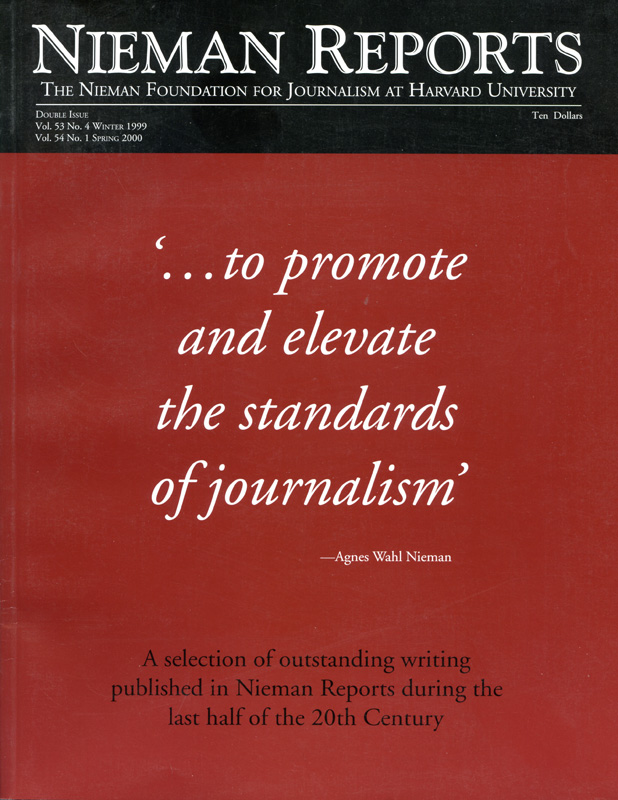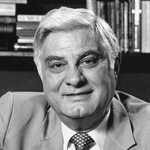The American press was halfway through the century just ended before journalists began to talk seriously about press responsibility.
A letter Henry Luce wrote to Robert Hutchins, President of the University of Chicago, prompted this conversation. "I know what my freedoms are under the First Amendment, but what are my responsibilities?" Luce wondered.
"I don’t know," Hutchins scribbled back. "Why don’t we form a commission to find the answer?"
This exchange took place about the time1937that Harvard advertised for its first class of Nieman Fellows. The inquiry was interrupted by World War II, but 10 years later the Hutchins Commission on Freedom of the Press completed its work. The report it issued, "A Free and Responsible Press," spawned the creation of Nieman Reports.
Archibald MacLeish, the first Curator of the Nieman Foundation, was a member of the Hutchins Commission. He alerted his successor as Curator, Louis Lyons, that the report would be released early in 1947. He also told him of one lament of the Commission: there was no forum for regular and serious criticism of the press.
By the time the report was released, Lyons and his 1947 class of Nieman Fellows had created Nieman Reports to fill that need. It was a publication which promised "no pattern, formula or policy except to seek to serve the purpose of the Nieman Foundation ‘to promote the standards of journalism in America.’"
What you hold here is a collection which reflects the substance of the first 53 years of the conversation journalists have engaged in about their rights and responsibilities in the pages of Nieman Reports. At times you will find an article that opened a new argument or ended an old one. Throughout you will hear the voices of journalists committed to their work challenging colleagues to raise the standards of discovering, reporting, writing and editing the news in a context meaningful for navigation within a free society.
Culling the content of Nieman Reports since its founding was a work of devotion on the part of five readers: Assistant Editor Lois Fiore, Editor Melissa Ludtke (NF ’92), Robert Manning (NF’46), Lindsay Miller (NF ’88), and me.
Obviously, reducing more than half a century of Nieman Reports to 224 pages means many memorable articles never made the final cut and must remain in the archives.
Those that survived were guided by Melissa Ludtke’s vision for the issue. Here’s how she spelled that out:
"Each reader will take responsibility for reading Nieman Reports for a 10-year period.
"In reading these journals, judgments will need to be made constantly about whether a particular article should be recommended for inclusion Does the article do an excellent job of defining or exploring an issue in journalism? Does an article stand out because of its provocative nature? Does it simply stand out because of its fine writing[or] are there themesexemplified by the particular article?"
The collection opens with a brief excerpt of Louis Lyons’s review of the conclusion of the Hutchins Commission: "[T]hey came out with the warning that only a responsible press can remain free. This is an urgent warning to the interests in control of the press. It is going to be a hard one to brush off or forget as so many criticisms of less weight have been brushed off and ignored."
Some in the press didn’t find the warning hard to ignore. George Sokolsky, for example, wrote in the Tampa Daily Times: "It just shows how dumb these professors are to put radio in front of the newspaper in a study of the press."
But many in the press in general, and the Nieman Foundation in particular, took the notion of journalistic responsibility to heart. Discussion about what this responsibility entails weaves a common thread through writings that span more than five decades, a remarkable stretch of time during which extraordinary changes occurred in how news is and can be delivered and how it is even defined. Though technological change has at times seemed to bring with it erosion in some of the core values that have guided journalists, at least in these pages discussion continues about what core values ought to be vigilantly preserved. It is interesting to observe how each time technologic or economic events threaten to usher in changes in journalistic practiceswhether it be the arrival of television, the consolidation of newspaper ownership, or emergence of the Internetthe conversation among journalists returns to an exploration of fundamentals, of the core principles which define journalism.
The articles are organized chronologically by topic. You will see how the discussion of a subject areadeveloping and using sources, for examplehas changed (and at the same time been constant) over the years. Naturally enough the broad category of journalism, which opens this issue, is itself the largest subject area. In here you will discover what may be the most eloquent and best description of journalism that ever has been published, "The Pursuit of Journalism" by Thomas Griffith, a senior editor at Time (NF’43). His words evoke the spirit as well as the reality of journalism, explain its great promise, and provide fair warning of its limitations.
"Journalism is in fact history on the run," Griffith wrote. "It is history written in time to be acted upon: thereby not only recording events but at times influencing them. Journalism is also the recording of history while the facts are not all in."
You will also find a description of newspaper journalism that owners in today’s market-driven world might want to clip and save. The article is, "For That Hole in the Forms." It is by Edwin A. Lahey, a member of the first Nieman class.
"Newspapering is a mass production, assembly-line manufacturing process, first and foremost," Lahey wrote. "And like any other manufacturing process, the assembly line shuts down if the customers don’t buy the merchandise. But there is a slight difference. [T]he First Amendment, a simple and well-worn phrase packed both with opportunity and responsibility."
In a way every journalist will recognize the evolution of journalism between 1947 and 1999 recorded herein is a story of sameness and change, of a world undergoing fundamental shifts in economic organization and technological possibilities but held together by (but at times barely clinging to) some core principles.
"‘I’ve never seen the press corps quite so frustrated,’ a Washington reporter told me" writes one of this issue’s authors. Of course, this sentiment might be the boilerplate lead on any story chronicling complaints of journalists during any of these decades. But this particular quote is the opening line in a story called "The Captive Press," written by Douglass Cater. His is a cry against the "frozen patterns" of reporting in the early 1950’s that turned press coverage into a convenient conduit for the destructive character assassinations put forth by Senator Joseph McCarthy. Arguments about how news ought to be reported continue to this day.
By the end of the century, in a discussion about investigative reporting ("Reporters’ Relationships With Sources"), a group including Pulitzer Prize-winning reporters remind us of how newsbreaking stories don’t require the use of anonymous sources. These journalists tell how they broke stories examining criminal conduct in some of the most sensitive areas of life and did so without relying on unnamed sources or becoming the tool of any interest save the truth.
The magazine chronicles the performance and shortcomings of the press as it monitored the 1960’s and 1970’s, decades when profound societal changes reshaped the nation and the world. Editorials written by Southern Niemans such as Harry Ashmore (NF ’42), in Arkansas, and Hodding Carter (NF ’40), in Mississippi, remind us of the discomforting tightrope newspaper editors walked in fighting for tolerance in the face of murderous white hate, a murderous hate profiled by Simeon Booker (NF ’51) in his coverage of the Mississippi trial for the murder of a black man, Emmett Till.
The emergence of the new feminist movement, Peggy Simpson (NF’79) points out, was first met with "disbelief and ridicule" by much of the press. As Simpson noted, women, who had begun entering journalism in increasing numbers found themselves performing a balancing act, too. As they tried to shape their careers by covering prominent stories, they were also trying to bring awareness into the newsroom of stories and perspectives not previously covered.
The American journalists’ declaration of independence of military and political control is captured in "Reflections on Vietnam, the Press and America," an article by Peter Arnett. "God knows we are not perfect as professionals," he wrote. "But if I am to be judged, better in the broad context of the American press tradition than in the narrow interests of venal politicians or partisan colleagues."
Against this backdrop of conflict, challenge and change, Anthony Lewis (NF ’57) wove the encouragement of the courts as they steadily expanded press freedom. "Over the last two decades," he wrote in "The New Reality," "judges have interpreted the First Amendment generously, even imaginatively, to protect freedom of speech and press. They have given editors what I think is beyond doubt the widest measure of legally, enforceable independence that exists, perhaps that ever has existed, in any country."
There was in this period, too, the excitement of discovery as new and important advances in the craft of journalism found their way into the pages of Nieman Reports. Philip E. Meyer (NF ’67) introduced a new precision into journalism by using tools of social science, mathematics and analysis. Anthony DeCurtis, Senior Features Editor of Rolling Stone, explained how "political and social realities" can be learned through the often overlooked reporting contained in serious criticism of popular music.
The rest of the century seems almost a blur as social, political, economic and technological change continued to challenge traditional behavior in all aspects of our personal and professional lives. Throughout this anthology, however, you will hear clearly the voices of journalists who argue persuasively for holding on to the enduring principles of journalism so as to act in the public interest. In articles (and excerpts from articles) such as those that follow, this message emerges as a clarion call:
- "Backdoor Editorializing," by John L. Hulteng (NF ’50).
- "Has Money Corrupted Washington Journalism?" by James S. Doyle (NF ’65).
- "Does Press Freedom Include Photography?" by Joseph Costa.
- "Media Power and the Dangers of Mass Information," by Michael J. O’Neill.
- "Feasting on the Seed Corn," by Alex S. Jones (NF ’82).
- "Endangered Species," by David S. Lamb (NF ’81).
Most of all, you will find in this sampling of the first half-century of Nieman Reports the urge of journalists to perfect their craft. These journalists represent the contributions made to this magazine by so many others whose words have been inspiring to those of us who had the privilege to work on this issue. Reading these back issues helped me to realize how critical it is to maintain a serious dialogue among ourselves about our craft. As writer after writer reminds us, it is not the job of those outside of journalism to define what we will become or how we will do our work. But if we don’t do the hard work of examining and reexamining decisions we make in the light of our enduring principles then we will fail in our obligation to maintain a responsible press. And without a responsible press, the fabric of our social community and our democratic process begins to fray.
It is this obligation for which this issue of Nieman Reports is only a reminder.



